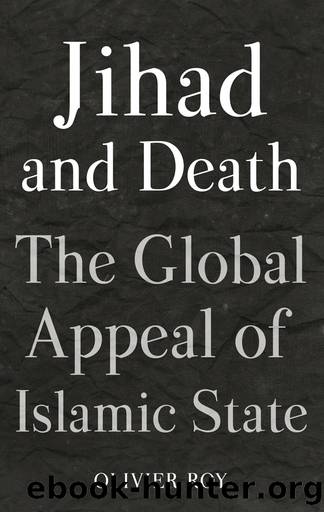Jihad and Death by Roy Olivier;

Author:Roy, Olivier;
Language: eng
Format: epub
Publisher: C. Hurst and Company (Publishers) Limited
Published: 2017-08-15T00:00:00+00:00
Deculturation of the Religious Sphere and Symbolic Violence
I can now return to the question posed at the beginning of this book: Why in the space of twenty years has radicalization primarily affected second generations and converts? It is because these two categories, due to their situation or by choice, have lost the culturally rooted religion of their parents. They thus piece together a religion without any social and cultural grounding, as do the Salafis. They even take pride in their deculturation, as it transforms these marginalized misfits into ideal actors of a globalization that levels everything out. They are thus open to religious fundamentalism and the search for a global cause, or rather a “global person,” that would render pointless the roots they lack.
These phenomena of deculturation and religious reconstruction are not of course specific to second generations and converts alone, even if these two categories are more likely to find themselves in situations of conflictual deculturation. This also occurs in situ. It certainly explains the overrepresentation of Maghrebans (along with the high percentage of radicals from the former Soviet Union) in international jihadism. The language conflict is indeed at its most intense in spaces such as these. In the Maghreb, competition between local languages (Berber and darija Arabic), French, and classical Arabic certainly produces high-level intellectuals who are perfectly trilingual, but it leaves in limbo all those who have poor literacy skills in each of these languages. Postcolonial Arabization has had effects that are almost as negative as the Francization policy of the colonial period. The situation is the same in the former Soviet countries. The communist regime’s battle against traditional forms of Islam had the effect of preparing a tabula rasa for the Salafis and jihadis. If Chechens and Dagestanis are overrepresented among jihadis, it is probably because, in these two former republics, the generational schism was strongest in the former (deportation of Chechens in 1944) and the linguistic schism deepest in the latter (due to the lack of a common language among Dagestanis, who used Russian). The same phenomenon occurred among Kosovar jihadis, far more numerous in proportion than their Albanian brothers. The older ones have been enrolled by ISIS in a “Yugoslav” battalion, in other words an environment in which the common language is Serbo-Croat (it is interesting to note that the most recent avatar of Yugoslav identity is a “jihadi battalion” based in Syria!); and the younger ones, who do not speak Serbo-Croat, are enrolled in an “Albanian” battalion.29 On the other hand, Turks in Europe are underrepresented in international jihadism because the transmission of their traditional language and religion is maintained (Dutch jihadis are mostly Maghrebans and converts). But youths of Pakistani origin are also overrepresented in radicalism, as are blacks among converts (and this is true all over Europe). The language question is central in Pakistan, as Urdu tends to vanish in migration; it is the mother tongue of only a small minority, and is replaced by English as the language of communication within the community.
Download
This site does not store any files on its server. We only index and link to content provided by other sites. Please contact the content providers to delete copyright contents if any and email us, we'll remove relevant links or contents immediately.
| Africa | Americas |
| Arctic & Antarctica | Asia |
| Australia & Oceania | Europe |
| Middle East | Russia |
| United States | World |
| Ancient Civilizations | Military |
| Historical Study & Educational Resources |
Rasputin by Joseph T. Fuhrmann(560)
Russian Revolution: A Concise History From Beginning to End (October Revolution, Russian Civil War, Nicholas II, Bolshevik, 1917. Lenin) (One Hour History Revolution Book 3) by Hourly History(334)
The Russian Revolution: A Very Short Introduction (Very Short Introductions) by S. A. Smith(332)
FROM RUSSIA, WITH LOVE by Ian Fleming(323)
Moscow Monumental by Katherine Zubovich(320)
The Russian Five by Keith Gave(310)
Reconstructing Lenin: An Intellectual Biography by Krausz Tamás(303)
Authoritarian Nightmare by John W. Dean & Bob Altemeyer(299)
Winter is Coming by Gary Kasparov(297)
Kremlin Rising by Peter Baker(273)
Io dirò la verità by Germano Maifreda(258)
Spetsnaz: The Inside Story of the Soviet Special Forces by Viktor Suvorov(243)
Russia Resurrected by Kathryn E. Stoner;(234)
My Further Disillusionment in Russia by Emma Goldman(233)
Voices From Stalingrad by Bastable Jonathan;(227)
13 KGB by Unknown(217)
The Russian Revolution in Ukraine (March 1917 â April 1918) by Nestor Makhno & Nestor Makhno(212)
Jihad and Death by Roy Olivier;(200)
Russian Revolution, 1917 (9781108109161) by Wade Rex A(187)
